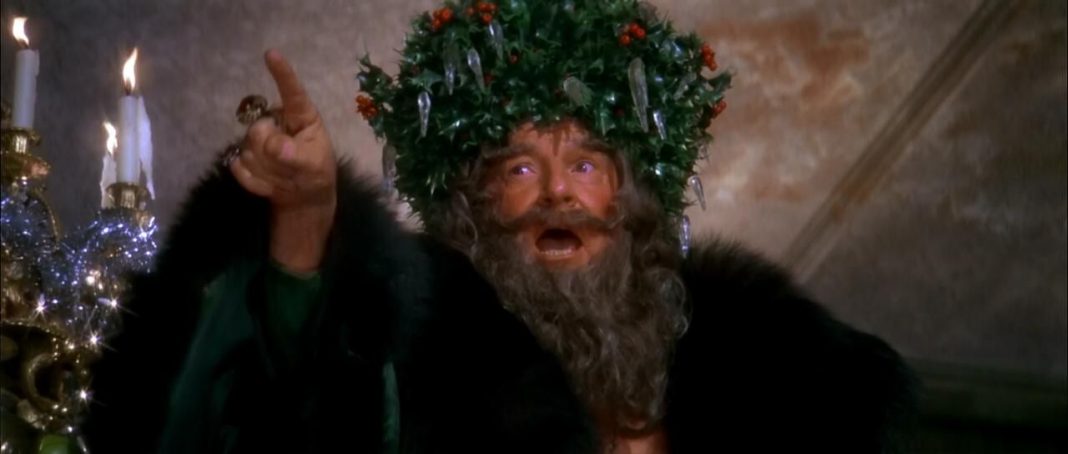Man shall not live by bread alone, but popcorn and eggnog will suffice until the main courses arrive.
Last year on Christmas Eve we watched two holiday-themed films. First came the somber and elegiac The Dead (1987), followed by Scrooge (1970), the musical version of the Dickens classic with Albert Finney starring. They’re considerably different in terms of intent, but equally memorable. What’s more, it’s almost impossible to imagine either of them being produced today.
Finney is a colossus in Scrooge, appearing in almost every scene; the songs won’t be familiar to contemporary listeners, but they’re effective in creating the necessary set pieces. As an example, “I Hate People,” which I concede to be a ditty that kept flitting in and out of my consciousness during the 2020 election season.
Scavengers and sycophants and flatterers and fools
Pharisees and parasites and hypocrites and ghouls
Calculating swindlers, prevaricating frauds
Perpetrating evil as they roam the earth in hordes
Feeding on their fellow men
Reaping rich rewards
Contaminating everything they see
Corrupting honest me like me
Humbug! Poppycock! Balderdash! Bah!
I hate people! I hate people!
Scrooge has been Mrs. Baylor’s go-to for a long time, and after much effort, she converted me. A whole generation of identifiable British actors appears, including Kenneth Moore, whose turn as the Ghost of Christmas Present is my favorite part.
When Scrooge first encounters the Ghost of Christmas Present, the spirit is sitting on an enormous throne made out of food. The components include suckling pigs, sausages, chestnuts, an assortment of fruits and barrels of oysters. While you might not be able to afford an entire barrel of oysters today (they were cheap back in 1800s England), a dozen or so served on the half-shell are the perfect Christmas hors d’œuvres.
Now for the pivot: The novelist Joyce, in The Dead, on a Christmas spread in Dublin.
A fat brown goose lay at one end of the table, and at the other end, on a bed of creased paper strewn with sprigs of parsley, lay a great ham, stripped of its outer skin and peppered over with crust crumbs, a neat paper frill round its shin, and beside this was a round of spiced beef. Between these rival ends ran parallel lines of side-dishes: two little minsters of jelly, red and yellow; a shallow dish full of blocks of blancmange and red jam, a large green leaf-shaped dish with a stalk-shaped handle, on which lay bunches of purple raisins and peeled almonds, a companion dish on which lay a solid rectangle of Smyrna figs, a dish of custard topped with grated nutmeg, a small bowl full of chocolates and sweets wrapped in gold and silver papers and a glass vase in which stood some tall celery stalks. In the centre of the table there stood, as sentries to a fruit-stand which upheld a pyramid of oranges and American apples, two squat old-fashioned decanters of cut glass, one containing port and the other dark sherry. On the closed square piano a pudding in a huge yellow dish lay in waiting, and behind it were three squads of bottles of stout and ale and minerals drawn up according to the colours of their uniforms, the first two black, with brown and red labels, the third and smallest squad white, with transverse green sashes.
The Dead is a faithful and thought-provoking rendering of James Joyce’s enduring short story, and it was director John Huston’s final work.
Probably I first read James Joyce’s Dubliners during college, or shortly thereafter. It is a compelling collection of short stories completed by Joyce during his pre-WWI residency in Trieste, as published in 1914. The Dead is the final story, and the capstone of the book in every way. As short stories go, it’s long; almost a novella. John Huston’s adaptation is quite short as feature films go, although no less compelling for its brevity.
The Economist’s pseudonymous columnist plainly gets it, and so should we all: “The festive season has summoned every weeping ghost.” So it will remain for me, always.
Forget “A Christmas Carol” — “The Dead” is the greatest Christmas story, by Prospero (The Economist)
James Joyce’s captivating tale is one of love, loss and loneliness
ALMOST EVERYONE who watches television in Ireland will have seen a Christmas commercial for Guinness—first aired in 2004—in which snowflakes drop softly over a variety of Irish landscapes. Although the writer got no credit from the advertising agency, this panorama of longing and nostalgia draws on James Joyce’s short story “The Dead”. Joyce’s tale concludes (freakishly, in purely meteorological terms) with snowfall “general all over Ireland”. His snow unites past and present, memory and desire, as it blankets “all the living and the dead”.
“The Dead” is among the finest short stories in the English language. Astonishingly, it came from the pen of an impoverished and insecure 25-year-old language teacher in Trieste. In that Italian city, ruled then like the Dublin he had left by a haughty imperial power (Austro-Hungary rather than Great Britain), the self-exiled Joyce lived and wrote. He sought for years to find a reliable publisher for the collection eventually released, in 1914, as “Dubliners”. Written in 1907, “The Dead” displays all the virtuosity of an author who can already do anything he wants in conventional fiction. Like Pablo Picasso, his near-contemporary, Joyce would soon break all the rules of the art he had so precociously mastered.
For more than a century, readers have loved “The Dead” for its bittersweet melancholy and its mingled threads of festivity and mourning. It inspired John Huston’s film of 1987, the great actor-director’s poignant swansong.
As for Huston’s adaptation, this from legendary film critic Pauline Kael:
“Huston directed the movie, at eighty, from a wheelchair, jumping up to look through the camera, with oxygen tubes trailing from his nose to a portable generator; most of the time, he had to watch the actors on a video monitor outside the set and use a microphone to speak to the crew. Yet he went into dramatic areas that he’d never gone into before – funny, warm family scenes that might be thought completely out of his range. Huston never before blended his actors so intuitively, so musically.”
Man shall not live by bread alone, but there’s always food for thought, not to mention an evening’s parting glass of tawny port.
Christmas greetings from F&D’s table, to yours.























